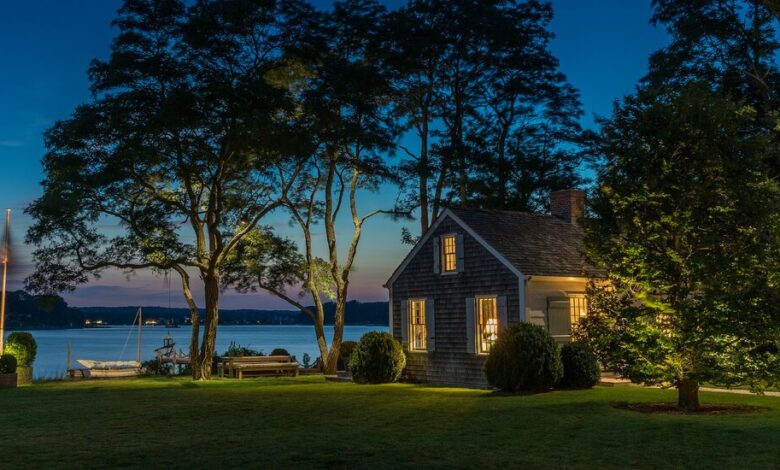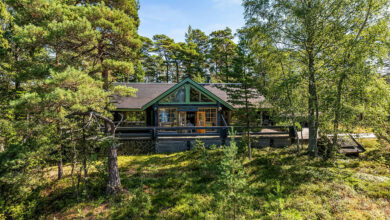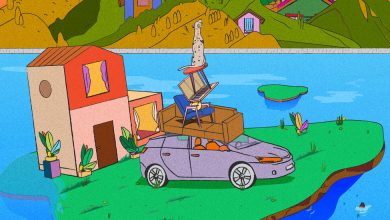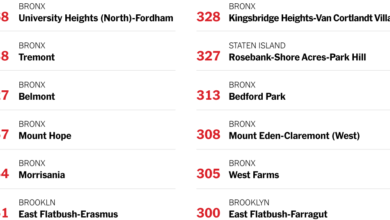How to Light Your Patio or Yard Without Annoying Your Neighbors

It’s that time of year again. Gardens, terraces and yards are coming alive with greenery. Outdoor furniture is being dusted off. But don’t forget the one thing you really need for enjoying your outdoor space at night: outdoor lighting.
Why does it matter?
“Especially in the city, most people experience their gardens at night more than they do during the day,” said Stephen Eich, the urban studio director at Hollander Design, a landscape architecture firm based in New York. “We’re always super conscious about making sure that it’s well illuminated and inviting, just so people can enjoy their garden.”
Light is also essential for outdoor activities like grilling and dining — and so your guests can see where they’re going. “From a safety standpoint, lighting is pretty important, particularly if you have any grade changes or material changes,” said Daniel Nolan, a landscape designer in San Francisco.
But maybe most important of all is the magical feeling that outdoor lighting conjures. “It just changes the mood,” said Jeffrey Salcito, the founder of the Brooklyn-based garden design firm Huntergreen. “Even if a space is very industrial, just adding string lights is going to instantly make it a more enjoyable space.”
With so many options to choose from — string lights, LED fixtures, rechargeable lamps and more — we asked designers of landscapes and lighting to share their advice.
Focus on Warm, Gentle Light
Don’t even think about blasting your garden with floodlights. To create an outdoor space that people actually want to spend time in, most designers try to create subtle, glare-free illumination. That means installing layers of gentle light focused on different areas and functions.
“What that does is it creates a more subtle contrast between the light and the dark, which actually allows you to see more, while making everything feel better,” said Nathan Orsman, a lighting designer with offices in New York, Southampton and Miami.
Most exterior lights are now LED. “But the trouble with LED lights is that they tend to be very white and very bright,” said Scott Shrader, a landscape designer based in West Hollywood, Calif.
He and Mr. Orsman both suggested finding LED lights that offer a warm-white color temperature of about 2,700 Kelvin, as well as low-wattage fixtures that aren’t blinding. (Mr. Shrader often uses fixtures that consume just 2.5 watts each.)
If you plan to use multiple fixtures, Mr. Orsman suggested buying a single light to test it before placing a big order.
“Everyone’s version of 2,700 Kelvin is slightly different,” he said. Regardless of what’s printed on the box, “it’s not as fixed as you would think.”
Consider the View From Inside
Outdoor lighting isn’t just useful when you’re outside — it also improves the view from indoors.
“Whenever we’re working on lighting landscapes, we’re always trying to break the reflection on windows from the interior,” Mr. Eich said.
At night, a window looking onto a dark garden will act like a black mirror, making it difficult to see anything outside. A little lighting on the other side of the window can reduce reflections and help you see through the glass. That’s beneficial even on colder days when you don’t go outside.
“If you have a terrace that’s been landscaped and you can see it from your kitchen, or another room, it expands your sense of space,” Mr. Salcito said.
Begin With General Illumination
There are many ways to give large gardens and yards a subtle glow.
One of Mr. Shrader’s favorites is known as moonlighting: mounting multiple low-voltage fixtures in trees so they cast a light resembling that of a full moon on a clear night. “It’s the most beautiful lighting, from my point of view,” he said.
He often sets fixtures from Lightcraft Outdoor through tree branches to project arboreal shadows downward. “You cross them through the branches so that it gives you this beautiful pattern on the ground,” he said.
If your yard is fenced, another option is to mount multiple low-voltage sconces directly to the fence, a technique Mr. Salcito often uses in Brooklyn backyards. On a small terrace, one or two sconces mounted on an exterior wall works well.
Uplight Features
To give specific trees, plantings or sculptural features a dramatic boost, designers often uplight them with fixtures on the ground.
Hollander Design sometimes uses uplights to highlight an allée or a pair of trees. “A lot of times, we’re playing up symmetry or just the overall order of the garden,” Mr. Eich said. “Typically, we’ll choose trees that have interesting features, like the exfoliating bark on river birches or the smooth, muscly bark on a beech tree.”
Mr. Shrader has used uplights to accentuate the texture of a weathered brick wall, and Mr. Salcito has used them to show off vine-covered fences.
Illuminate Paths
To lead guests through a garden, consider lighting pathways with low-voltage landscape lights on short stakes. Some have a mushroom-shaped shade that reflects a circle of light onto the ground, while others have a head that provides more directional light, like a spotlight.
For stairs, consider recessed step lights. And if your outdoor space has built-in benches or elevated platforms and landings, you may want to tuck LED strip lights underneath them.
“That’s really nice, because when you’re in an area with furniture, it often becomes a black hole in the garden,” Mr. Nolan said, because it can be difficult to add landscape lights where there is no soil.
Address Specific Functions
Illuminating a dining area, kitchen, reading nook or other functional outdoor space requires a different approach. In those cases, it’s not just about creating an inviting glow or helping people to see where they’re going — it’s about providing light for specific activities.
If there is a pergola overhead, one option is to hang a decorative pendant, lantern or chandelier, as you might illuminate an indoor dining room. For a more streamlined look, Mr. Shrader often integrates LED downlights into a pergola frame, so they’re nearly invisible.
If there’s no pergola, there are other creative options. “Where we don’t have an overhead structure, we can use string lights, going from tree to tree, to provide that illumination,” Mr. Eich said.
Mr. Orsman also uses string lights (some of which come with shatter-resistant LED bulbs), even in landscapes with more elaborate lighting systems. “All of our clients like them,” he said. “Who doesn’t?”
Embrace Flexibility
Candle lanterns, hurricanes and votive holders are easy, portable options for lighting a table or a seating area. “Candles are a really important aspect of a lighting program,” Mr. Shafer said. “Just because they bring so much mood and elegance to an outdoor space.”
The biggest trend changing how people illuminate outdoor spaces, however, is the rise of portable, rechargeable LED lights from companies like Zafferano, Smart and Green and Fermob.
“One of the most amazing things we have now, that we didn’t before, is the incredible range of options in rechargeable lamps,” Mr. Orsman said, which can simply be carried outside as needed.
Indeed, not all light fixtures you use outdoors need to live there all the time — or even be designed for outdoor use. Mr. Shafer sometimes carries indoor lamps outside and plugs them into exterior outlets. “I’ll have a whole bar set up and I’ll just go and plug a lamp in, just for the night I’m entertaining,” he said. “That’s kind of fun.”
Be a Good Neighbor
As you add light fixtures to your outdoor space, there’s one major caveat: Be mindful of your neighbors.
“One of the biggest mistakes people make is they go overboard on lighting and then become that neighbor, where it looks like a resort,” Mr. Nolan said. “That’s the last person you want to be.”
If neighboring outdoor spaces are dimly lit, try to avoid making your own space too bright, Mr. Nolan suggested. And definitely avoid directing light at nearby windows.
Mr. Orsman also recommended putting landscape lighting on a timer, to avoid accidentally leaving it on all night. “I don’t like anything on all night,” he said. “You should always try to be respectful of your neighbors.”
For weekly email updates on residential real estate news, sign up here.
Source link






